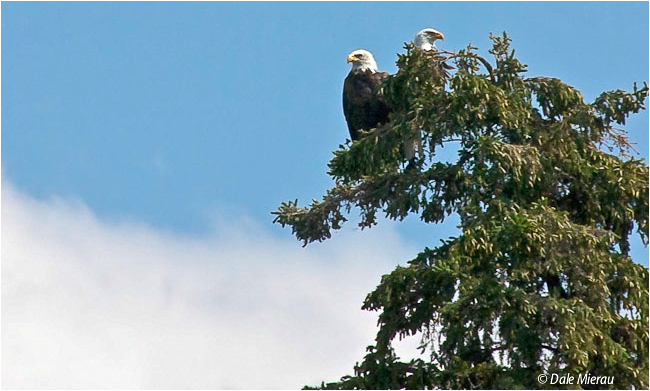
Photographing Eagles on Lac LaRongeby Dale Mierau
 Eagles mate for life and return to the same nest each year. Each year the pair adds material to the nest. Large nests can a reach diameter of over four meters and weigh more than a ton. One of the pair stays at, or near, the nest during the 35-day incubation period. After hatching, the eaglet will remain in the nest for 12 weeks before it attempts to fly, and another 8 weeks before it leaves for good. My experiment with digital photography began with a number of point and shoot digital cameras including a Canon S2IS. A few years ago I graduated to a Pentax K10D with an 18-250 mm lens. During the summer months I live on an island on Lac LaRonge in the Precambrian shield region of Northern Saskatchewan (55.0871367N- 105.063715W ). An aerial photo of the area and its local topography can be viewed here.
The bald eagle (Haliaeetus leucocephalus – ‘white headed sea-eagle’) is unique to North America. Bald eagles tend to live and breed near bodies of water with an area of no less than 10 square kilometers. Lac LaRonge is a large lake that covers 1414 square kilometers dotted with hundreds islands. The Lac LaRonge area boasts the highest inland concentration of breeding bald eagles in the world. Eagles arrive at Lac LaRonge in early May (just before break-up) and leave in late October before freeze-up.
Eaglets are prodigious eaters and grow very quickly. Young eagles attain a weight of 3 kilograms within the first 8 weeks. The first attempt at fledging is made twelve weeks after hatching. The fledging process is the most dangerous time for eagles. It is estimated that approximately 25 to 40% of eagles die while during this time, some from the fall and some because of an inability to return to the nest. The young eagle seen here has made it. Bald eagles reach maturity at five years of age when they display the distinctive white head and tail feathers. In a life span of 30-40 years, a female eagle can grow to 6 kg with a wingspan of 2.5 meters. Two eagle pairs breed within five kilometers of the island. A pair of adult eagles perch on a tall tree on a small island about 400 meters from our home. Eagle perches are easy to find, the weight of the eagle causes a distinctive ‘flattening’ of the treetop.
One of the best times to approach an eagle is during the time when the eaglet is in the nest. During this time the adults demonstrate strong territorial behavior.
One cannot sneak up on an eagle and it is difficult to photograph an eagle that is wary of your approach. When this three-year-old eagle perceives a threat, it drops down behind its perch and flies away under cover.
Eagles are not likely to perch on a short tree in the presence of a threat. Most my photographs are taken from a small boat. It took many hours over years before the local eagles would to allow me to approach a perch within 10 meters without flying. I’ve been following this eagle’s development since it hatched four years ago. It will sport the distinctive white head and tail feathers when it returns the following year.
If one can approach an the eagle that is on such a perch, with a backdrop of a rock face or trees, the eagle has no choice but to fly toward the photographer. The use of a small boat as a platform for photography presents challenges. I find it necessary to keep the outboard motor running so I can approach while avoiding the rocks that lurk under the water. The eagles don’t seem to mind the running motor but they tend to fly when I reach to shut it off. An outboard motor that is running creates vibration; not good for photography. One way to address the transfer vibration to the camera is to stand rather than sit. It is much easier to frame, focus and pan while standing.
The series of images below were taken while I was standing in the boat just after placing a fish on an exposed rock. The male eagle took off and flew over me. The degree of familiarity demonstrated in these images is unusual for a wild eagle.
I have known this old girl for 19 years. She has distinctive markings and extraordinary bulk. She lost her mate some year ago, no longer breeds and spends her time alone, Most of the time she puts up with me and doesn’t mind my company. I have the print up at home in Saskatoon.
Many of my images suffer from a lack of sharpness and demonstrate chromatic aberration. To improve my chances at getting better photographs I will get a super-telephoto prime lens and improve a system of camera stabilization while in a boat. I wonder how long it will take before I drop the whole apparatus into the lake?
|









